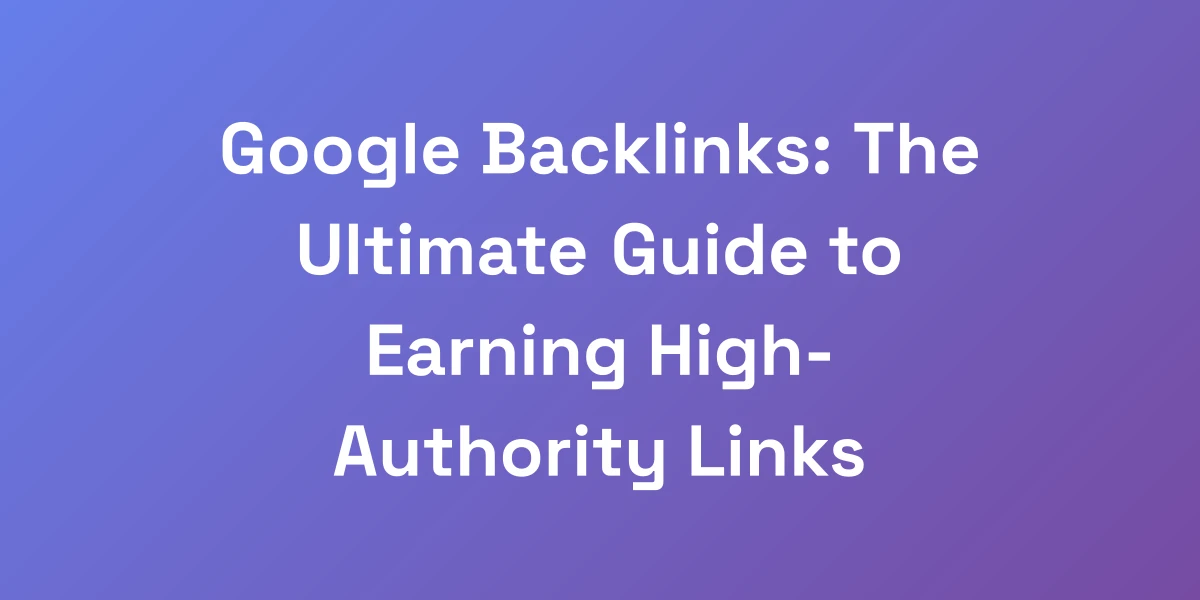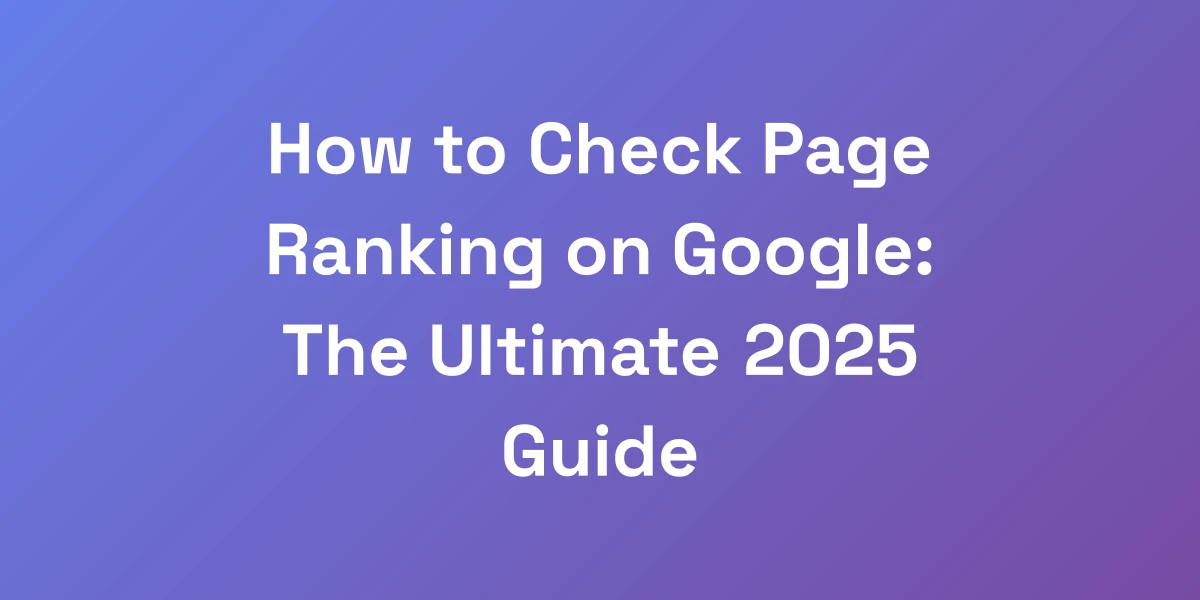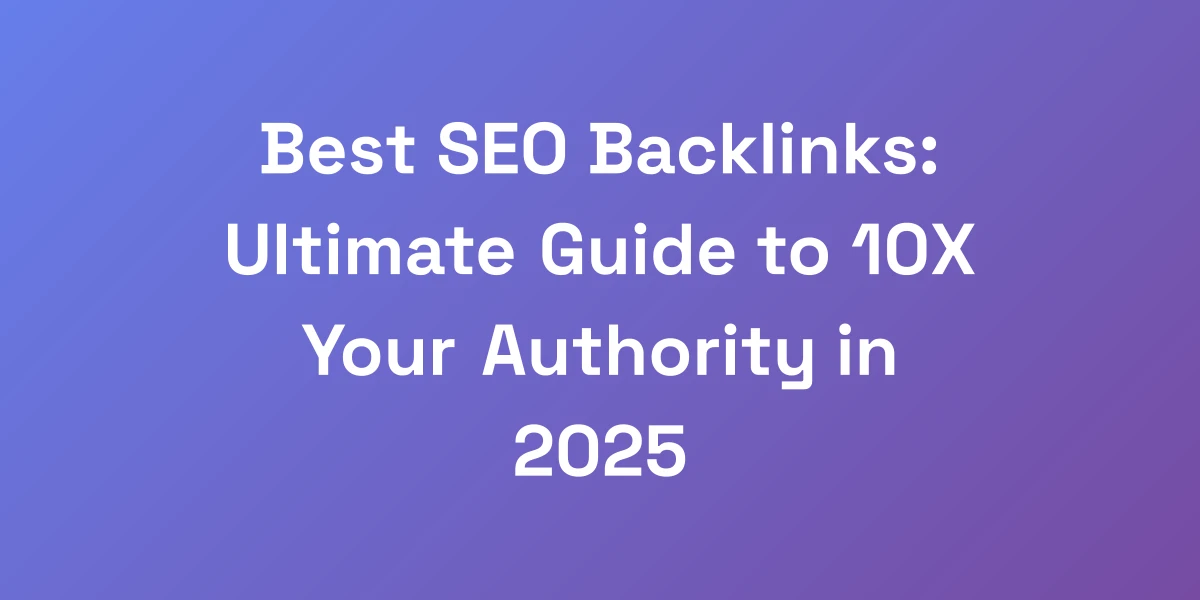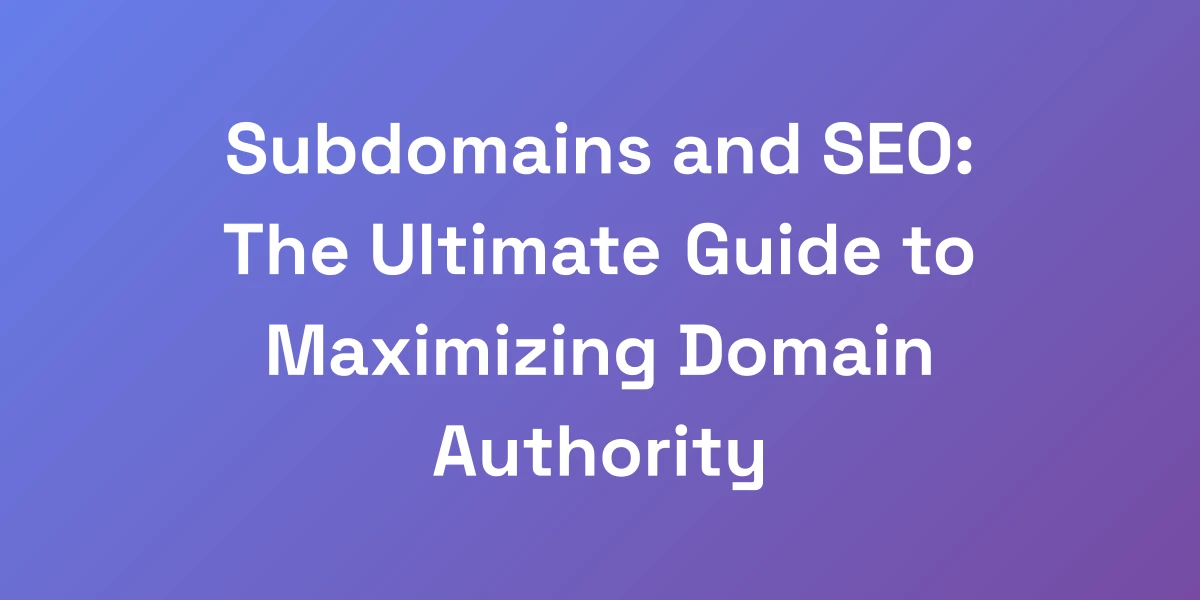
Google Backlinks: The Ultimate Guide to Earning High-Authority Links
Apr 3, 2025 | By [email protected]
Introduction
Ever felt like climbing an endless mountain with Google ranking as the peak? We get it. Backlinks have long been the secret sauce to skyrocketing your website’s authority, but navigating the ever-evolving landscape of Google backlinks can feel like deciphering an ancient code.
In 2025, the rules have shifted dramatically. What worked a few years ago? It won’t cut it today. If you’re still chasing quantity over quality, you’re setting yourself up for a fall. But here’s the thing: mastering high-authority backlinks isn’t just about following trends—it’s about understanding the core principles that drive Google’s algorithm updates.
Let’s face it, earning valuable backlinks isn’t easy. It requires strategy, creativity, and a deep understanding of how Google evaluates links. The challenges are real, but so are the rewards. Stick with us as we dismantle the myths, reveal the truths, and equip you with the actionable strategies you need to dominate your niche with high-authority backlinks.
Understanding Google’s Evolution on Backlinks in 2025
Let us cut through the noise and give you the unfiltered truth about how Google views backlinks today. Our extensive testing and experience have shown that backlinks still hold significant weight, but the game has completely changed.
Gone are the days when you could spam your way to the top. Google’s AI is now incredibly adept at spotting artificial links. What worked in 2020? It might get you penalized in 2025. So, what exactly has shifted?
The Shift from Quantity to Quality Signals
Back in the day, we could amass hundreds of links from almost anywhere and watch our rankings soar. Now, it’s all about quality over quantity.
Google’s latest updates prioritize links that offer genuine value. It’s not enough to have a vast network of backlinks; each link must contribute meaningfully to your site’s authority.
- High-Authority Sources: Links from reputable sites like major news outlets or industry leaders carry far more weight.
- Contextual Relevance: A backlink is only as good as its relevance to your content. Random links are no longer effective.
- User-Centric Value: The linked content should enhance the user’s experience and provide real value.
How Google’s AI Evaluates Link Authority
Google’s AI doesn’t just count links; it analyzes them.
Machine learning models assess the trustworthiness and relevance of each backlink. This means your links aren’t just numbers—they represent endorsements from credible sources. Implementing SEO automation can help manage and maintain these high-quality backlinks efficiently.
- Trustworthiness: Links from highly trusted domains are more valuable.
- Relevance: Backlinks from sites related to your industry are given higher priority.
- Engagement: The level of interaction and traffic a linking site has can influence its authority.
Impact of Natural Link Velocity
Backlink velocity—the rate at which you acquire links—plays a critical role.
Sudden spikes can raise red flags, suggesting manipulative practices. A natural, steady growth of backlinks looks much healthier to Google.
- Consistent Growth: Gradually increasing your backlinks signals organic growth.
- Avoiding Spikes: Sudden influxes of links can trigger penalties.
- Variety of Sources: Diversified backlink sources contribute to a natural link profile.
Content Relevance in Link Assessment
Relevance is king. Google evaluates how closely a backlink relates to your content niche.
Imagine a tech blog being linked by a leading health site—it doesn’t make much sense, right? Relevance ensures that backlinks are meaningful and beneficial.
- Thematic Alignment: Backlinks should align with your content themes.
- Topical Relevance: Ensure the linking content is relevant to your industry or topic.
- Contextual Placement: Links embedded within relevant content carry more weight.
Trust Signals That Matter in 2024
Trust signals are the backbone of link authority. These include the linking site’s reputation, security (HTTPS), and its own backlink profile.
- Site Reputation: High-trust sites lend more credibility to their backlinks.
- Secure Protocols: HTTPS-linked sites are favored over non-secure ones.
- Quality Backlinks: Sites with their own strong backlink profiles provide better trust signals.
The Real Truth About Buying Backlinks
Let’s get real about buying backlinks—we’re cutting no corners here. The truth? Google doesn’t necessarily care if you paid for a link. What matters is whether the link appears natural and adds value.
We’ve seen companies throw $50,000 at “premium” links and watch their rankings plummet, while others spend just $500 wisely and dominate their niche. What’s the difference? It’s all about strategy and understanding what Google truly values.
Google’s Stance on Paid Links
Google’s policy is clear: buying links that pass PageRank is against their guidelines. But here’s the kicker—they’re less concerned about the transaction and more about the outcome.
- Natural Appearance: If the link looks organic and beneficial, the method of acquisition might not matter.
- Value Addition: Links should add value to the content and user experience.
- Transparency: Transparency in sponsorships and disclosures can help maintain link integrity.
Risk Assessment Framework
Not all link purchases are created equal. Assessing the risks involves understanding the potential benefits and pitfalls.
- Source Credibility: Only buy links from reputable sources.
- Relevance: Ensure the linking site is relevant to your industry.
- Link Context: The link should fit naturally within the content.
- Long-Term Impact: Consider how the link will affect your SEO in the long run.
Detection Patterns to Avoid
Google’s algorithms are trained to spot unnatural link patterns. Avoid these common pitfalls:
- Excessive Exact Match Anchors: Overusing keyword-rich anchors can appear manipulative.
- Low-Quality Sites: Links from spammy or irrelevant sites are easily detected.
- Speed of Acquisition: Rapid link building efforts often trigger penalties.
- Unnatural Link Distribution: A uniform distribution of links doesn’t mimic natural growth.
Strategic Link Acquisition
It’s not about how much you spend, but how strategically you spend it. Here’s how to acquire links that Google loves:
- Target High-Authority Sites: Focus on linking from reputable and relevant sites.
- Create Valuable Content: Develop content that’s worth linking to naturally.
- Build Relationships: Network within your industry and utilize digital marketing for agencies to earn organic links.
- Leverage PR: Use public relations strategies to gain high-quality backlinks.
Case Studies: Success vs. Failure
Let’s look at real-world examples of what works and what doesn’t:
- Success: A tech startup invested in creating comprehensive guides and resource pages. They then reached out to industry blogs and earned backlinks from authoritative sites, boosting their rankings significantly.
- Failure: Another company bought bulk links from low-quality directories. Their sudden link influx led to a Google penalty, causing a sharp decline in their search rankings.
High-ROI Link Building Strategies That Actually Work
Building high-ROI backlinks isn’t about following outdated methods like guest posting or broken link building. It’s about creating what we call link attraction assets—content that naturally accumulates high-authority backlinks without you having to beg for them.
Here’s how you can create these assets and watch your backlinks grow organically:
Creating Linkable Asset Types
What makes a piece of content link-worthy? It has to offer something unique and valuable. Here are the types of assets that attract high-authority links:
- Comprehensive Guides: In-depth resources that serve as go-to references in your industry.
- Infographics: Visually appealing content that presents data in an easily digestible format.
- Research Studies: Original research and data that others in your industry would want to cite.
- Tools and Calculators: Interactive resources that provide real value to users, including autoblogging platforms.
Outreach That Gets 80% Response Rates
Effective outreach is a blend of strategy and personalization. Here’s how to achieve impressive response rates:
- Personalized Emails: Address the recipient by name and mention specific details about their site.
- Clear Value Proposition: Explain how linking to your content benefits their audience.
- Follow-Up: Don’t be afraid to send polite follow-up emails if you don’t hear back initially.
- Build Relationships: Engage with potential partners on social media and through their content before reaching out.
Leveraging Industry Relationships
Relationships are the cornerstone of effective link building. Here’s how to leverage them:
- Networking: Attend industry events, webinars, and forums to connect with key influencers.
- Collaboration: Partner on projects, co-author content, or conduct joint research to create natural linking opportunities.
- Mutual Promotion: Promote each other’s content, fostering a collaborative environment that benefits both parties.
Data-Driven Content Strategies
Using data to inform your content strategy ensures you’re creating assets that resonate and attract links:
- Identify Gaps: Use tools like Ahrefs or SEMrush to find content gaps in your niche.
- Trend Analysis: Stay ahead by creating content around trending topics and emerging industry issues.
- Audience Insights: Understand what your audience is searching for and create content that meets their needs.
Scaling Link Acquisition
As your link building efforts start to pay off, it’s time to scale strategically:
- Automate Outreach: Use tools like Mailshake or Outreach.io to manage and scale your outreach efforts efficiently.
- Replicate Success: Identify which strategies are working and scale them across different content types and channels.
- Outsource: Hire skilled professionals or agencies who can help expand your link building efforts without compromising quality.
Measuring and Maximizing Link Value
Most SEOs are measuring the wrong metrics when it comes to backlinks. They obsess over Domain Authority while ignoring the signals that actually move the needle. Through our testing across hundreds of sites, we’ve identified the exact link building statistics that correlate with ranking improvements. Here’s the framework we use to evaluate every potential link opportunity, and why it works so consistently…
Key Performance Indicators
To truly measure link value, focus on these KPIs:
- Referral Traffic: The amount of traffic driven from the backlink source.
- Engagement Metrics: Bounce rate, time on site, and pages per visit from referred traffic.
- SEO Impact: Improvement in keyword rankings and overall search visibility.
ROI Calculation Framework
Understanding the return on investment for your backlink efforts is crucial:
- Initial Cost: Calculate the total investment spent on acquiring the backlink.
- Benefit Realization: Measure the uplift in traffic, leads, and conversions attributable to the backlink.
- Long-Term Value: Assess the ongoing benefits from the backlink, beyond immediate gains.
Link Quality Scoring System
Implement a scoring system to evaluate the quality of each backlink:
- Authority: Score based on the Domain Authority and trustworthiness of the linking site.
- Relevance: Evaluate how relevant the linking site is to your niche.
- Engagement: Consider the engagement metrics of the linking site’s audience.
- Link Placement: Priority given to contextual links within high-quality content.
Competitive Link Analysis
Analyzing your competitors’ backlink profiles can reveal opportunities and gaps in your own strategy:
- Identify Competitors: Determine who your main SEO competitors are.
- Backlink Gaps: Find out which high-authority sites are linking to them but not to you.
- Opportunity Identification: Target these sites with your link assessment solutions.
Long-term Value Assessment
Focus on the enduring value of backlinks:
- Evergreen Content: Links to content that remains relevant over time tend to be more valuable.
- Authoritative Endorsements: Ensure backlinks come from sources that are consistently authoritative.
- Ongoing Relevance: Regularly update your content to maintain its link-worthiness.
Future-Proofing Your Link Profile
Listen, Google’s algorithm updates have wiped out countless businesses that relied on outdated link building tactics. But there’s a way to build a link profile that becomes more valuable with each update, not less. Let us share the exact process we use to future-proof our clients’ backlink profiles against any algorithm changes. This strategy has helped us maintain rankings through every major update since 2021.
Sustainable Link Building Practices
Sustainability in link building means focusing on practices that will stand the test of time:
- Quality Content: Continuously create valuable content that naturally attracts links.
- Ethical Outreach: Build genuine relationships and seek collaborations that benefit both parties.
- Consistent Efforts: Regularly update and promote your content to keep it relevant and link-worthy.
Risk Mitigation Strategies
Protect your link profile from potential penalties with these strategies:
- Diverse Link Sources: Avoid relying too heavily on one type of backlink or source.
- Regular Audits: Conduct periodic backlink audits to identify and disavow harmful links.
- Natural Growth: Ensure your backlink growth rate remains steady and organic.
Diversification Techniques
A diversified link profile is less vulnerable to algorithm changes:
- Multiple Content Types: Use blogs, infographics, videos, and other content forms to attract different kinds of links.
- Variety of Sources: Secure backlinks from a mix of high-authority sites, niche directories, and local businesses.
- Different Link Formats: Acquire a mix of dofollow and nofollow links to create a balanced profile.
Algorithm Update Protection
Stay ahead of Google’s updates with proactive measures:
- Stay Informed: Keep up with the latest SEO news and algorithm changes.
- Adapt Quickly: Be ready to pivot your strategy based on new algorithm signals and guidelines.
- Continuous Learning: Invest in ongoing education and training to keep your SEO skills sharp.
Long-term Strategy Planning
Think beyond immediate gains and plan for sustained success:
- Set Long-term Goals: Define clear objectives for your backlink strategy that align with your overall business goals.
- Monitor Performance: Regularly track the performance of your backlinks and their impact on your SEO.
- Iterate and Improve: Continuously refine your strategies based on performance data and industry trends.
Conclusion
Let’s recap the key takeaways. High-authority Google backlinks remain a cornerstone of effective SEO, but the approach has evolved. We’ve seen a clear shift from quantity to quality, with Google’s AI now meticulously evaluating link authority, relevance, and natural growth patterns. Understanding and adapting to these changes is crucial for any serious SEO strategy.
Avoid the pitfalls of buying links indiscriminately. Instead, focus on building sustainable, high-quality backlinks through strategic content creation and genuine relationship building by incorporating digital marketing for small businesses. Implement our tested frameworks for measuring link value and future-proof your backlink profile to withstand any algorithm updates.
Ready to elevate your backlink strategy? Start by creating link-worthy assets that provide real value, engage with authoritative sites in your niche, and consistently monitor and refine your efforts. The path to high-authority backlinks is a marathon, not a sprint, but with the right strategies, the rewards are well worth the effort.
Have questions or want to share your own link building successes? Drop a comment below or reach out to us directly. Let’s build a stronger, more authoritative web together!








